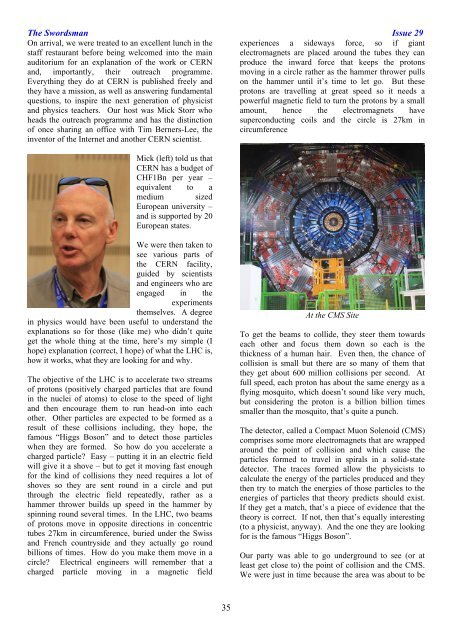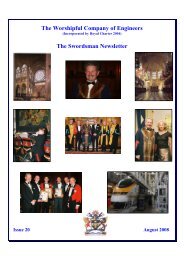The Worshipful Company of Engineers The Swordsman Newsletter ...
The Worshipful Company of Engineers The Swordsman Newsletter ...
The Worshipful Company of Engineers The Swordsman Newsletter ...
Create successful ePaper yourself
Turn your PDF publications into a flip-book with our unique Google optimized e-Paper software.
<strong>The</strong> <strong>Swordsman</strong> Issue 29<br />
On arrival, we were treated to an excellent lunch in the<br />
staff restaurant before being welcomed into the main<br />
auditorium for an explanation <strong>of</strong> the work or CERN<br />
and, importantly, their outreach programme.<br />
Everything they do at CERN is published freely and<br />
they have a mission, as well as answering fundamental<br />
questions, to inspire the next generation <strong>of</strong> physicist<br />
and physics teachers. Our host was Mick Storr who<br />
heads the outreach programme and has the distinction<br />
<strong>of</strong> once sharing an <strong>of</strong>fice with Tim Berners-Lee, the<br />
inventor <strong>of</strong> the Internet and another CERN scientist.<br />
Mick (left) told us that<br />
CERN has a budget <strong>of</strong><br />
CHF1Bn per year –<br />
equivalent to a<br />
medium sized<br />
European university –<br />
and is supported by 20<br />
European states.<br />
We were then taken to<br />
see various parts <strong>of</strong><br />
the CERN facility,<br />
guided by scientists<br />
and engineers who are<br />
engaged in the<br />
experiments<br />
themselves. A degree<br />
in physics would have been useful to understand the<br />
explanations so for those (like me) who didn’t quite<br />
get the whole thing at the time, here’s my simple (I<br />
hope) explanation (correct, I hope) <strong>of</strong> what the LHC is,<br />
how it works, what they are looking for and why.<br />
<strong>The</strong> objective <strong>of</strong> the LHC is to accelerate two streams<br />
<strong>of</strong> protons (positively charged particles that are found<br />
in the nuclei <strong>of</strong> atoms) to close to the speed <strong>of</strong> light<br />
and then encourage them to run head-on into each<br />
other. Other particles are expected to be formed as a<br />
result <strong>of</strong> these collisions including, they hope, the<br />
famous “Higgs Boson” and to detect those particles<br />
when they are formed. So how do you accelerate a<br />
charged particle? Easy – putting it in an electric field<br />
will give it a shove – but to get it moving fast enough<br />
for the kind <strong>of</strong> collisions they need requires a lot <strong>of</strong><br />
shoves so they are sent round in a circle and put<br />
through the electric field repeatedly, rather as a<br />
hammer thrower builds up speed in the hammer by<br />
spinning round several times. In the LHC, two beams<br />
<strong>of</strong> protons move in opposite directions in concentric<br />
tubes 27km in circumference, buried under the Swiss<br />
and French countryside and they actually go round<br />
billions <strong>of</strong> times. How do you make them move in a<br />
circle? Electrical engineers will remember that a<br />
charged particle moving in a magnetic field<br />
35<br />
experiences a sideways force, so if giant<br />
electromagnets are placed around the tubes they can<br />
produce the inward force that keeps the protons<br />
moving in a circle rather as the hammer thrower pulls<br />
on the hammer until it’s time to let go. But these<br />
protons are travelling at great speed so it needs a<br />
powerful magnetic field to turn the protons by a small<br />
amount, hence the electromagnets have<br />
superconducting coils and the circle is 27km in<br />
circumference<br />
At the CMS Site<br />
To get the beams to collide, they steer them towards<br />
each other and focus them down so each is the<br />
thickness <strong>of</strong> a human hair. Even then, the chance <strong>of</strong><br />
collision is small but there are so many <strong>of</strong> them that<br />
they get about 600 million collisions per second. At<br />
full speed, each proton has about the same energy as a<br />
flying mosquito, which doesn’t sound like very much,<br />
but considering the proton is a billion billion times<br />
smaller than the mosquito, that’s quite a punch.<br />
<strong>The</strong> detector, called a Compact Muon Solenoid (CMS)<br />
comprises some more electromagnets that are wrapped<br />
around the point <strong>of</strong> collision and which cause the<br />
particles formed to travel in spirals in a solid-state<br />
detector. <strong>The</strong> traces formed allow the physicists to<br />
calculate the energy <strong>of</strong> the particles produced and they<br />
then try to match the energies <strong>of</strong> those particles to the<br />
energies <strong>of</strong> particles that theory predicts should exist.<br />
If they get a match, that’s a piece <strong>of</strong> evidence that the<br />
theory is correct. If not, then that’s equally interesting<br />
(to a physicist, anyway). And the one they are looking<br />
for is the famous “Higgs Boson”.<br />
Our party was able to go underground to see (or at<br />
least get close to) the point <strong>of</strong> collision and the CMS.<br />
We were just in time because the area was about to be




